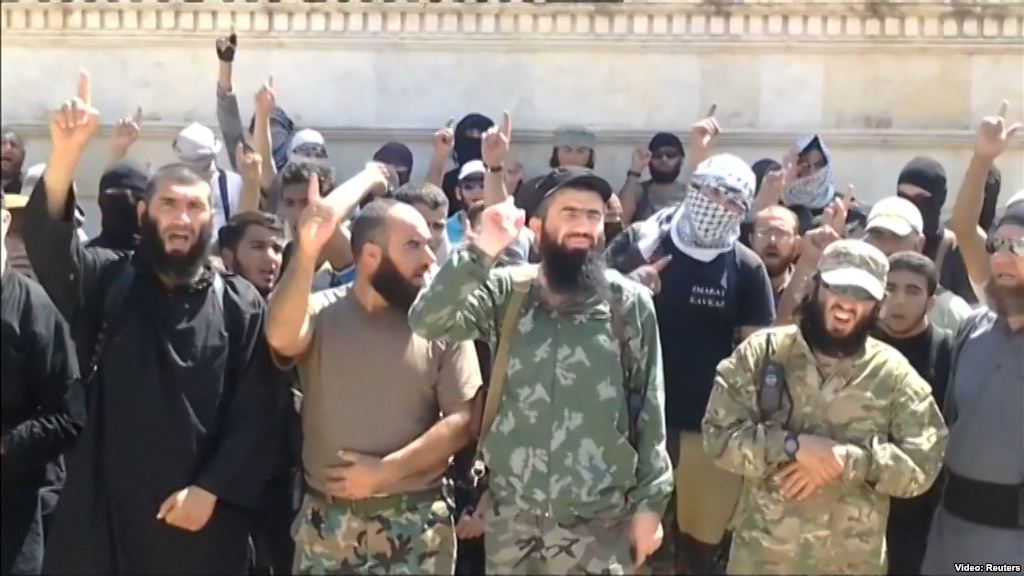
Slain Rebel Leader in Kabardino-Balkaria Fought in Syria
Publication: Eurasia Daily Monitor Volume: 11 Issue: 107
By:

In the first five months of 2014, Russia’s Federal Security Service (FSB) prevented six terrorist attacks and killed 130 militants (echo.msk.ru, June 10). The absolute majority of these attacks took place in Dagestan, but there were also special operations in nearby regions that resulted in the deaths of both suspected militants and the law enforcement personnel. Several such operations have been conducted in Kabardino-Balkaria since May, under the aegis of the National Anti-Terrorist Committee (NAK).
On June 9, the head of the regional FSB branch in Kabardino-Balkaria introduced counter-terrorist operation regimes in four villages of Zolsky district—Shardakovo, Svetlovodskoe, Zolskoe and Zalukodes (Kommersant, June 10). The operation was prompted by an incident near the city of Baksan on June 9, when shots were fired from a car after it was stopped by the police. Four alleged armed resistance members were killed in the incident and their car exploded—according to the NAK, the result of the detonation of an improvised explosive device (IED) inside the car that had the force of 2 kilograms of TNT. The NAK said in a statement that the slain militants, Muhamed Balagov, Askerbi Khandokhov, Muhamed Bagov and their leader, Adam Shigalukov, were implicated in attempts to kill law enforcement personnel, along with murders and extortion. One of the militants was on the international wanted list, according to NAK. Two Kalashnikovs, a handgun and hand grenades were found on the slain individuals (Kavkaz Uzel, June 10).
It is not entirely clear why the grenades that were found in the car did not explode (skfonews.info, June 10). The NAK did not pay attention to details like that. Kabardino-Balkaria’s Zolsky district has always been one of the hotbeds of the underground movement in the republic. The district’s strategic location has made it attractive to the insurgents because it is located in the northwestern part of the republic, bordering Stavropol region, Karachaevo-Cherkessia, and the Baksan and Elbrus districts of Kabardino-Balkaria (zolka.ru). After the shootout on the Kavkaz highway, a counter-terrorist operation regime was introduced in the area of the village of Islamei, which is located in the suburbs of Baksan, and extended to all adjacent villages. However, after just several hours, the counter-terrorist operation regime was lifted (news-r.ru, June 10). The FSB must have had some information about other suspects located in the area; otherwise, there was no reason to introduce a counter-terrorist operation regime after destroying the car and identifying the slain insurgents inside it. The counter-terrorist operation regime was later lifted without any additional reports of incidents (e-kbr.ru, June 10)
Adam Khabizhevich Shigalukov, a.k.a. Emir Adam, was well-known in Kabardino-Balkaria for having fought in Chechnya and more recently in Syria. An ethnic Kabardian (Circassian), the 32-year-old leader came from the Zolsky district village of Svetlovodskoe. The government put him on the federal wanted list (07.mvd.ru) on the basis of Article 208, Part 2 of the Russian Criminal Code: “Participation in an armed formation not designated by federal law, also participation in an armed formation of a foreign state not designated by the legislation of that state with goals that contradict the interests of Russian Federation” (zakonrf.info, April 2014).
Apparently, the authorities brought the charges based on Emir Adam’s participation in the conflict in Syria against Bashar al-Assad’s regime. This means that the authorities failed to prevent the return of a participant in the war in Syria, which is a bad omen for the FSB. If one person managed to make it into Russia, dozens of other militants hardened in the Syrian fighting might also come back. This was probably one of the reasons why the Kremlin decided to place Shigalukov on the international wanted list (ITAR-TASS, June 10).
The website of the Main Directorate of the Russian Ministry of Interior in the North Caucasian Federal District has information about placing Shigalugov on the international wanted list. According to the Russian interior ministry, on November 28, 2013, a city court in Nalchik, Kabardino-Balkaria, ordered detention in absentia for Shigalukov as a preventive measure, based on Article 208, Part 2 and Article 282, Part 2 of the Russian Criminal Code—the establishment of an extremist organization (skfo.mvd.ru).
The slain rebel emir was suspected of multiple crimes, including the notorious murder of cab drivers in the Stavropol region in January 2014 (Kavkaz Uzel, June 9). The cab drivers incident was seen as an attack to destabilize the region in the run up to the Winter Olympic Games in Sochi in 2014.
The story of Emir Adam indicates a new dimension to the armed resistance of the North Caucasians—one connected to Ukraine. The situation in Ukraine may have a direct impact on the situation in the North Caucasus, in the sense that the North Caucasian volunteers fighting in Syria may return home through Ukraine. Making use of the problems between Russia and Ukraine, the latter will become a transit territory in both directions. Syria-Instanbul-Ukraine (or Moldova) will become attractive options for those who decide to leave the war in Syria and return home.
Thus, this Russian security services special operation sheds light on the changes within the armed resistance movement and its ability to adapt to the changing environment in and around Russia. This renders the North Caucasian underground movement a more dynamic force than one could imagine. It is highly probable that many novelties in the jihadists movement in this region will surface in the near future and the recent case in KBR demonstrates this type of new reality.




